
Most string bands, for comic relief, had one member who sported an outrageous outfit, with painted-on glasses and freckles and blacked-out teeth.This is Hank "Elmer" Warren of the Briarhoppers.


Most string bands, for comic relief, had one member who sported an outrageous outfit, with painted-on glasses and freckles and blacked-out teeth.This is Hank "Elmer" Warren of the Briarhoppers.
|
Fisher Hendley and his Carolina Tarheels of Albemarle, N. C., who broadcast every Saturday night." |
An early WBT orchestra. In those early years many such groups performed, for, with little network programming, there were many hours to fill. All manners of musical groups came from across the Carolinas to get on the airwaves. Young men aspiring to be announcers were hired as "pages," who seated the audience and conducted tours of the station. Announcers wore tuxedos. |
From a booklet published in the 1920s, a portrait of the Woodlawn String Band. The members are not identified. It's a good bet they were mill workers in one of Charlotte's many cotton mills. Did they buy new overalls as costumes, or just use their work clothes? Note the art deco lightning bolts framing the photos, indicating that we're talking radio here. From reader Ed McIntosh: "Going through the effects of my late uncle, Bob Hice, who worked at WBT and WBTV, I came across the same picture, without the lightning bolts, and with all of the members identified on the back. The picture was made on March 9, 1929 by J.W.Mann. Their names are: Van Hice, Mr. Isenhour, Milas Eastwood, (another) Mr. Isenhour, Alex Hice, Ern Ritch and Mr. Sweet."
|
Some of the members of the WBT orchestra. The complete personnel list consists of: Israel Smith, Violin; Mary Ray Palmer, Cello; Max Englehardt, Flute; Elsie Stokes Moseley, Piano; Edgar Huston, Bass viol; Maurice Marco, Clarinet; Michael Wise, Violin; Lucille Talbert, Violin; Howard Beatley, Drums." |
The original Carter Family(from left: Maybelle, Sara and A. P.) was heard from time to time on WBT in the early 1930s, before moving to San Antonio to broadcast by transcription over several high-powered Mexican border-based stations. By this time Maybelle's three daughters, Anita, June and Helen were part of the group. The Carters came back to WBT in 1941 for a couple years. The excellent Carter Family biography, Will You Miss Me When I'm Gone, tells how they couldn't find a house or apartment in wartime Charlotte, so they stayed at the Roosevelt Hotel. "Their radio show aired live, every morning as the farmers got up and going, from 5:15 to 6:15. Monday through Saturday, the Carters wakened before dawn, fixed hot biscuits and gravy in the little kitchenette, and made their way to the station [in the Wilder Building]...After the show was over Helen and June would take the Piedmont and Northern railroad out to Paw Creek High School." In March of 1943, when their WBT contract expired, the Original Carter Family disbanded. Maybelle took the girls to Richmond where, in June, they began work for WRNL as "The Carter Sisters and Mother Maybelle." |
Another group, sponsored by RCA Victor, was Arthur Wenige and the Ramon Brothers. The dapper announcer reading from the script is Charles Crutchfield, who came to the station in 1933, and by the mid-'40s was running the place. In those days practically every group had a tenor but very few had one named RCA Victor. |
|
|
In the late 1930s WBT and other stations broadcast weekly "barn dances" sponsored by Crazy Water Crystals, which, according to it's advertising, would cure or be beneficial in the treatment of a whole litany of diseases of the alimentary tract, the urinary tract, kidneys and gall duct. As 1940 ended, the Federal Trade Commission found the claims were a fraud, and that, at best, the product worked as a laxative. Cease and desist this false advertising, the FTC said, and the WBT sales department surely went into shock. |
Some of the Barn dance acts, including The Monroe Brothers and Dick Hartman's Crazy Tennessee Ramblers, had daily 15-minute broadcasts on WBT. One of the Monroe Brothers, Bill, later became renowned as the father of bluegrass music. Byron Parker, called The Old Hired Hand, was the Monroe's announcer and sang bass when they performed hymns. Parker later formed his own group that included, among many others, a young picker/singer named Tommy Faile. |
|
|
Another popular Crazy Water Band in the mid-1930s was J. E. Mainer's Mountaineers. J. E. and his brother Wade were from Weaverville, N. C., but later moved to Concord and worked in cotton mills before getting into music. These "Crazy" groups were shuttled around between radio markets by Hubert Fincher, the "brain" behind the Crazy Water quackery. |
The Briarhoppers was the longest running country group on WBT, from its formation in 1935 until 1951. It was home-grown, assembled by Charles Crutchfield, station program director, who was the show's announcer. The program began with Orval Hogan asking, "Do ya’ll know what hit is?” The whole cast would shout in reply, “Hit’s Briarhopper time!” Whereupon the band would plunge into its theme song "Wait 'Til the Sun Shines, Nellie." Then, as now, radio artists and their reps couldn't resist being shills for patent medicine makers. Peruna, which was around for decades, claimed to cure whatever ailed you. It contained so much alcohol, its sale to Indians was prohibited. The only thing it was sure to cure was your sobriety |
|
The Briarhopper cast changed with each passing year. Here in 1941 Billie Burton and "Mildred" are part of the ensemble. In this incarnation, Hank Warren was not yet "Fiddlin' Hank" but was "Elmer" the mandolin player, and Whitey and Hogan had not joined the group. The announcer was Bill Bivens, who soon left Charlotte to became the announcer for The Fred Waring Program and other popular shows on network radio and TV. He returned to BT's warm embrace for a short time in the 1960s before his retirement. |
Another Briarhopper configuration. One constant presence was Bill Davis, the bass player. The pianist is Clarence Etters. The young mandolin player beside him is Homer Drye. Standing, from left: Don White, Bill Davis, three unidentified members, and Garnet "Elmer" Warren. |
|
||||||||||||||||
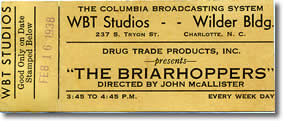 |
|||||||||||||||||
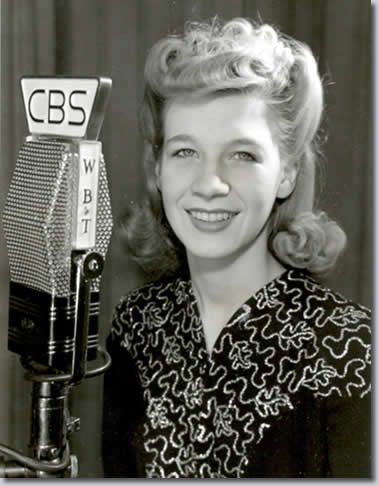
The WBT glamour girl of the '40s, Billie Ann Newman, was the station's “torch” singer who performed with various WBT bands on many different programs.
Billie was a guest singer on the Briarhopper Family radio show (pre-1940), on Holly Smith's amateur show and she starred on the Dixie Jamboree with the Briarhoppers and the Johnson Family.
She left WBT in 1948 after she got married, and left Charlotte in 1951 when her pilot-husband was transferred to Atlanta.
She went to WLWH in Atlanta to audition with a dance band. The radio host at the time said that she would be on the program that afternoon. He also took her name and number and shared it with many local bands so she would get enough work to make some money. Billie was on the radio host's show on WLWH five days a week for a year. He "had four children and was making $95 per week. He asked for $125 per week and was fired, saying he was not even worth $95." That radio host was Dick Van Dyke. He left the station and went to New Orleans where a talent scout saw him and landed him a part in Bye, Bye Birdie.
Billie moved to Raleigh in the 1960s and sang at jazz clubs in Myrtle Beach while working in Raleigh for the state. She retired in 1980s and moved back to Charlotte, where she died in 2008.
Betty Johnson of the Johnson Family Singers recalls, “I remember her so well and with great fondness. I must admit, I was a girl in pigtails and thought she was a Hollywood star. So glamorous! We sang together on the same program. The servicemen came to the studio and goggled—can't blame them.”
Photo courtesy Dirk Allman. Details fromTom Warlick, www.wbtbriarhoppers.blogspot.com
 |
 |
 |
 |
 |
 |
 |
The cast of Carolina Hayride. Originating at WBT, this program aired in the late 1940s on the Dixie Network, a southern "leg" of the CBS Radio network. The cast included (at least) three groups, the Johnson Family Singers (front row), the Briarhoppers (upper left) and Arthur Smith & The Crackerjacks (upper right). From left, front row: Jim Johnson, Betty Johnson, Bob Johnson, Grady Cole (emcee), Kenneth "Red" Johnson, Lydia "Ma" Johnson, Jesse "Pa" Johnson. Second row: Arval Hogan (of Whitey & Hogan), Garnet B. "Hank" Warren, Claude Casey, Dewey Price (stage name Danny O'Neill), Sonny Smith, Roy "Whitey" Grant (of Whitey & Hogan), Roy Lear. Top row: Bill Davis, Sam Poplin, Homer Christopher, Fred Kirby, Arthur Smith, Ralph Smith.
The Johnson Family Singers (circa 1946) From left: Jim, Bob, Kenneth, Betty, "Ma" and "Pa." They sang on WBT from December 29, 1940 to May,1951. Kenneth remembers that Ken Tredwell wrote and produced their daily show when it was sponsored by Quaker Oats. They recorded for Columbia Records and RCA Victor Records and performed all over the south. Their experiences at WBT and on the road are well-chronicled in Kenneth's book We Sang For Our Supper. |
Fred Kirby and Claude Casey were solo performers but were also, from time to time, identified with the Briarhoppers or Tennessee Ramblers. They appeared on Carolina Hayride and other country revues presented by WBT. |
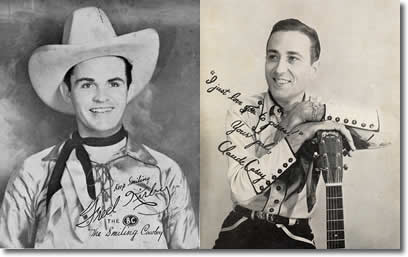 |
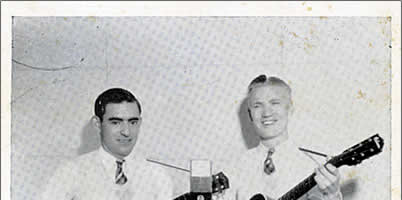 |
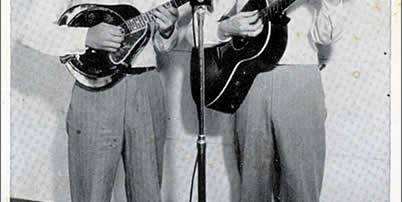 |
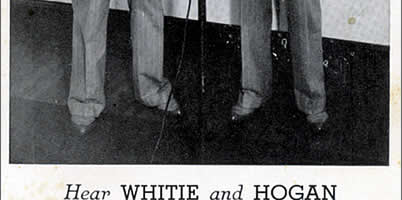 |
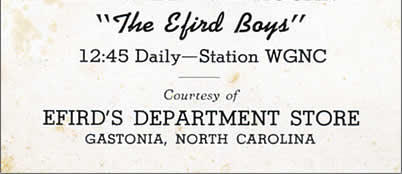 |
Whitey & Hogan. Roy "Whitey" Grant (right) was born in Shelby and Arval Hogan in Robbinsville, North Carolina. Like many of their generation, Whitey and Hogan migrated to the growing towns of the Piedmont in search of work. They met in 1935 in Gastonia while working at the Firestone textile mill.
Early in their singing career they were known as the "Spindle City Boys," and, for a stint on Gastonia's WGNC around 1939, they were billed as "The Efird Boys," after the department store that sponsored them.
Perhaps because of this exposure they were soon invited to join the Briarhoppers on WBT.
Photo courtesy Dirk Allman
 |
 |
 |
 |
 |
 |
Whitey & Hogan became a popular duet on the Briarhoppers soon after that group was formed.
After 1953, when the Briarhoppers retired from full-time music-making, Whitey and Hogan both worked for the Postal Service in Charlotte.
 |
 |
 |
 |
 |
 |
The Tennessee Ramblers. The group was formed in 1928 by Dick Hartman. In 1934 Crazy Water Crystals sent them to WBT. It became Cecil Campbell's band in 1945, and continued at WBT until the early '50s. Its members were somewhat interchangeable with the Briarhoppers crew. Don White, for example, might show up with either group. The Ramblers continued performing until the 1980s. This particular incarnation included, from left: Don White (real name Walden Whytsell), Kenneth "Pappy" Wolfe, Claude Casey and Cecil Campbell.
 |
 |
 |
 |
 |
 |
 |
 |
In the 1940s the most popular municipal venue in Charlotte for stage shows was the Armory Auditorium (later renamed Park Center, then Grady Cole Center). When touring and local groups assembled for "hayrides" or "jamborees," the Armory was the place, and WBT was usually the station that broadcast them.
1st row (l to r): |
Bob Johnson, Jim Johnson, Betty Johnson, Ken Johnson |
2nd row: |
Whitey & Hogan (Roy "Whitey" Grant and Arval Hogan) |
3rd row: |
Kenneth "Pappy" Wolfe, Garnet B. ("Elmer") Warren, Don White, Bill Davis, Fred Kirby, Pa Johnson, Ma Johnson, Claude Casey, Cecil Campbell. The next four men are members of the Rangers Quartet: Denver Crumpler (tenor), Arnold Hyles (Bass), Vernon Hyles (Lead); Walter Leverette (baritone). Larry Walker sits at the piano. |
| 4th row: | The Golden Gate Quartet. |
|
Another stage performance with some of the Briarhoppers cast, probably at the old Armory Auditorium. The emcee is Lee Kirby, WBT's sports reporter. From left: Arval Hogan, Bill Davis, ?, "Fiddlin' Hank" Warren, Lee Kirby, Claude Casey, Homer Christopher with accordion, Whitey Grant. |
 |
 |
 |
 |
 |
 |
The Golden Gate Quartet. They came to WBT in 1934 and remained there through the fifties. We have their names but can't assign them to the proper person. Jim Stick sang bass; Willie "Bill" Lanford was tenor; Henry Owens was the lead; Francis Ivy sang baritone; and Willie Johnson played guitar. In our sound vault there's an 11-minute clip of a show the quartet did in 1942 commemorating WBT's 20th anniversary.
 |
|
 |
|
 |
|
 |
|
Arthur Smith. Certainly the most renowned and versatile entertainer in the Carolinas, Arthur became known and appreciated around the world. Born in Clinton, S. C. and raised in Kershaw, he came to WBT in the early 1940s from WSPA in Spartanburg. His group, the Crackerjacks, was originally a Dixieland band, but soon turned toward country and gospel music. He and his brothers, Sonny and Ralph, were multi-talented. Arthur can play the fiddle, banjo and guitar. Best known for his huge hits, Guitar Boogie and Feudin' Banjos (co-written with Don Reno), Arthur has composed hundreds of songs and hymns. His group was a mainstay on WBTV for three decades.
Arthur and the Crackerjacks, an early version of the group, with Ralph Smith on bass, Roy Lear behind Arthur and Sonny Smith at right. |
|
 |
 |
 |
 |
 |
 |
 |
At some point in the 1950s the Crackerjacks were invited to New York to appear on Robert Q. Lewis' CBS program. Lewis would often substitute for Arthur Godfrey during vacation periods. This photo is probably of a planning session for their guest shot. Sitting, from left: WBTV's Wallace J. Jorgenson, WBTV's Paul Marion, Robert Q. Lewis, ?. Standing: Sonny Smith, Arthur Smith, Tommy Faile, Ralph Smith. In the medium gray suits are the Harvesters Quartet: David Reece, Hershel Wooten, Buddy Parker, Pat Patterson and Bill Hefner (sitting on stage). The Harvesters appeared for years on Arthur's morning and weekly evening shows. In 1974 Hefner would retire from music to win a U. S. Congressional seat that he held for 25 years.
 |
 |
 |
 |
 |
 |
Show time at the Robert Q. program. Lewis is shown at left at desk. The Crackerjacks are on stage, and Arthur seems to be delighting the audience with some deft guitar licks (Guitar Boogie?). If this indeed is a fill-in show for Arthur Godfrey while the Old Redhead was on vacation, the musicians behind the Crackerjacks are part of Archie Bleyer's orchestra. Although the lighting equipment is labeled "CBS TV" this is obviously a radio show, since there is no set or room for the big bulky TV cameras of the day.
 |
 |
 |
 |
 |
 |
 |
For many years the Crackerjacks did a weekday early morning show on WBTV (and a weekly half hour in prime time). The cast changed from time to time. In the '60s Sonny departed the act to run his own advertising agency. Arthur, Ralph, Tommy Faile and Wayne "Skeeter" Haas formed the core of the group as others came and went over the years. This photo from about 1970 shows, from left, Ralph Smith (accordion), Carl Hunt (banjo), Carlene "Sam" Howell (vocalist), Wayne Haas (bass), Arthur Smith (electric guitar), Kay Murray (vocalist), Jim Buchanan (fiddle), Tommy Faile (guitar and vocals)
Ralph Smith and Tommy Faile had a continuing routine as Brother Ralph and Cousin Phud, the "Counselors of the Airwaves." They would give "advice" to the lovelorn, the downtrodden and the misguided, who allegedly wrote (in crayon, on the backs of old speeding tickets) seeking the experts' wise counsel. Of course, Ralph and Tommy wrote the "letters" themselves and their solutions were just as outrageous and fantastical as the problems. |
|
 |
|
 |
|
 |
|
 |
|
 |
|
Tommy Faile was a star in his own right. Born in 1928 in Lancaster, S. C., he picked and sang and wrote songs all his life. His best known songs were "The Legend of the Brown Mountain Lights" and "Phantom 309," which he and others recorded. He remained with the Crackerjacks most of his career, although he had his own half-hour weekly prime-time show on WBTV for a couple of seasons in the early 1970s featuring country and popular tunes (also carried on WWBT in Richmond—another Jefferson station). The photo showing Tommy beside the conestoga was taken during taping of one of many Arthur Smith shows produced at Tweetsie Railroad at Boone, North Carolina. In the small photo at lower left Tommy is pickin' and grinnin' with some guy named Arthur Godfrey.